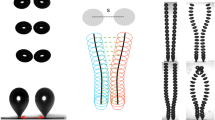Abstract
With the usage of a robust and efficient method, validated with literature data, numerical experiments were developed to analyze isolated rising bubbles and quantify fluid dynamic forces acting on them. An integral method is presented and used for the calculus, allowing the observation of the evolution of the total fluid dynamic force and the momentum rate of change in different types of rising bubbles. Drag coefficients were calculated and compared with literature correlations. Results showed that the present method is qualified to be applied for numerical experiments of isolated rising bubbles.














Similar content being viewed by others
References
Ascher UM, Ruuth SJ, Wetton BT (1997) Implicit-explicit methods for time-dependent pde’s. SIAM J Numer Anal 32:797–823
Baltussen M, Kuipers J, Deen N (2017) Direct numerical simulation of effective drag in dense gas–liquid–solid three-phase flows. Chem Eng Sci 158:561–568
Berger M, Colella P (1989) Local adaptive mesh refinement for shock hydrodynamics. J Comput Phys 82:64–84
Berger MJ, Rigoutsos I (1991) An algorithm for hyperbolic partial differential equations. IEE Trans Syst Man Cybern 21:1278–1286
Bhaga D, Weber ME (1981) Bubbles in viscous liquids: shapes, wakes and velocities. J Fluid Mech 105:61–85
Brackbill JU, Kothe DB, Zemach C (1992) A continuum method for modeling surface tension. J Comput Phys 100:335–354
Dijkhuizen W, Roghair I, Annaland MVS, Kuipers J (2010) Dns of gas bubbles behaviour using an improved 3D front tracking model—drag force on isolated bubbles and comparison with experiments. Chem Eng Sci 65(4):1415–1426. https://doi.org/10.1016/j.ces.2009.10.021
Fuster D, Bagué A, Boeck T, Moyne LL, Leboissetier A, Popinet S, Ray P, Scardovelli R, Zaleski S (2009) Simulation of primary atomization with an octree adaptive mesh refinement and vof method. Int J Multiph Flow 35(6):550–565. https://doi.org/10.1016/j.ijmultiphaseflow.2009.02.014
Gueyffier D, Li J, Nadim A, Scardovelli S, Zaleski S (1999) Volume of fluid interface tracking with smoothed surface stress methods for three-dimensional flows. J Comput Phys 152:423–456
Hirt CW, Nichols BD (1981) Volume of fluid (VOF) method for the dynamics of free boundaries. J Comput Phys 39:201–225
Hua J, Lou J (2007) Numerical simulation of bubble rising in viscous liquid. J Comput Phys 222:769–795
Lima RSD (2012) Desenvolvimento e implementação de malhas adaptativas bloco-estruturadas para computação paralela em mecânica dos fluidos. PhD thesis, Universidade Federal de Uberlândia, Uberlândia, MG
Lopez J, Hernandez J, Gomez P, Faura F (2004) A volume of fluid method based on multidimensional advection and spline interface reconstruction. J Comput Phys 195:718–742
Mei R, Lawrence CJ, Klausner JF (1994) A note on the history force on a spherical bubble at finite reynolds number. Phys Fluids 6:418–420
Milne RB (1995) An adaptive level set method. Technical report, Lawrence Berkeley Lab., CA
Nós RL (2007) Simulações de escoamentos tridimensionais bifásicos empregando métodos adaptativos e modelos de campo de fase. PhD thesis, Universidade de São Paulo, São Paulo
Pivello MR (2012) A fully adaptive front-tracking method for the simulation of 3D two-phase flows. PhD thesis, Universidade Federal de Uberlândia, Uberlândia
Popinet S (2009) An accurate adaptive solver for surface-tension-driven interfacial flows. J Comput Phys 228(16):5838–5866
Roghair I, Baltussen M, Annaland MVS, Kuipers J (2013) Direct numerical simulations of the drag force of bi-disperse bubble swarms. Chem Eng Sci 95:48–53
Roghair I, Lau Y, Deen N, Slagter H, Baltussen M, Annaland MVS, Kuipers J (2011) On the drag force of bubbles in bubble swarms at intermediate and high reynolds numbers. Chem Eng Sci 66(14):3204–3211. https://doi.org/10.1016/j.ces.2011.02.030
Roma AM (1996) A multilevel self adaptive version of the immersed boundary method. PhD thesis, New York University
Scardovelli R, Zaleski S (2003) Interface reconstruction with least-square fit and split Eulerian–Lagrangian advection. Int J Numer Methods Fluids 41(3):251–274
Shirani E, Ashgriz N, Mostaghimi J (2005) Interface pressure calculation based on conservation of momentum for front capturing methods. J Comput Phys 203(1):154–175
Sussman M, Almgren AS, Bell JB, Colella P, Howell LH, Welcome ML (1999) An adaptive level set approach for incompressible two-phase flows. J Comput Phys 148(1):81–124. https://doi.org/10.1006/jcph.1998.6106. http://www.sciencedirect.com/science/article/pii/S002199919896106X
Sussman M, Smereka P, Osher S (1994) A level set approach for computing solutions in incompressible two-phase flow. J Comput Phys 114:146–159
Tomiyama A, Kataoka I, Zun I, Sakaguchi T (1998) Drag coefficients of single bubble under normal and micro gravity conditions. JSME Int J Ser B 41:472–479
Tryggvason G, Scardovelli R, Zaleski S (2011) Direct numerical simulations of gas–liquid multiphase flows. Cambridge University Press, Cambridge
Villar MM (2007) Análise Numérica Detalhada de Escoamentos Multifásicos Bidimensionais. PhD thesis, Universidade Federal de Uberlândia
Wang Z, Yang J, Koo B, Stern F (2008) A coupled level set and volume-of-fluid method for sharp interface simulation of plunging breaking waves. Int J Multiph Flow 293:112–130
Acknowledgements
This work was sponsored by PETROBRAS (Cooperation Agreements No. 0050.0071368.11.9/4600344971) and CAPES.
Author information
Authors and Affiliations
Corresponding author
Additional information
Technical Editor: Jader Barbosa Jr., Ph.D.
Rights and permissions
About this article
Cite this article
Barbi, F., Pivello, M.R., Villar, M.M. et al. Numerical experiments of ascending bubbles for fluid dynamic force calculations. J Braz. Soc. Mech. Sci. Eng. 40, 519 (2018). https://doi.org/10.1007/s40430-018-1435-7
Received:
Accepted:
Published:
DOI: https://doi.org/10.1007/s40430-018-1435-7



